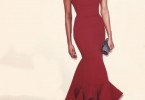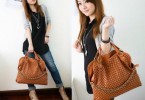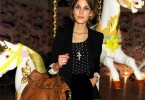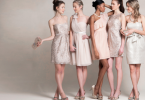The wedding season brings out the narcissist in not just the bride but also those associated with the event. And in answer to this, the designers go into creative overdrive to satiate the ‘Princess’ demanding that ‘most unique’ attire. At the recent Aamby Valley India Bridal Fashion Week (AVIBFW) 2013 in Mumbai; the popular verdict for the prevailing trend was once again mostly about glitz and glamour that bridal couples want. We bring here the top trends across fabrics, silhouettes, embellishments that were spotted in the wedding collections by the few top couturiers who presented their lines.
Top Fabric Trends
The fabric that rules the fashion charts for bridal wear and is favoured by all designers is tulle or net. It appears for lehengas, cholis, dupattas, kurtas, churidars, gowns, dresses. However, designers like Tarun Tahiliani, Pallavi Jaikishan and Neeta Lulla used Kanjeevaram for their creations along with thick jersey and satin which appeared occasionally.
Rohit Bal’s love affair with mulmul was so intense he used it for Elizabethan gowns and men’s wear and gave the fragile cotton material a new haute image along with Chanderis and voiles. Taffeta appeared for dramatic ball gowns created by Raghavendra Rathore, while lam© was the favoured fabric of all designers for its glitter and shimmer. Falguni and Shane Peacock kept the fabric story firm with chiffon, velvet and georgette along with large additions of lace. Brocades were used lavishly for many creations and at times as appliqu©s on net and organza that added a fragile appeal to cocktail and bridal wear in Jyotsna Tiwari’s collection. French jacquard, traditional Indian sari weaves with intricate motifs were the highlight of Pallavi’s creations
Top Silhouette Trends
Besides the conventional panelled flared lehengas, the fish tail and mermaid shapes added grandeur to the gowns. Kedia inspired jackets, lots of drapes, layers, wide palazzos and figure hugging gowns were the highlight. For men’s wear sherwanis were a constant from all designers, while the bundgala jacket was a big hit for men and women as shown by Raghavendra Rathore who teamed them for the fairer sex with long graceful skirts, dhoti pants, and Jodhpuri trousers.
The Nehru jacket or bundi appeared with kurtas in bright colours with lots of embroidery while Rohit Bal and J J Valaya ensured that the angarkhas were floor length, flared, layered creations for both sexes. Shantanu and Nikhil draped jersey tunics for men along with multi coloured ornate sherwanis. Kalidaar kurtas, shararas, angarkhas, chogas, lean tunics and swirling ghagras, along with farshi pyjama added an ethnic touch.
For Red Carpet glamour strapless gowns, halters, corsets, bustiers were a “must have” at times worn with boleros or shrugs. Gaurav Gupta pushed the envelope for silhouettes with Twisted Ripple, Fluid Pyramid, Sand Timer, Expanding Root and Liquid Creeper adding to the unconventional look of his collection. Floor length sheer capes made fashion statements with lehengas or churidars with tiny cholis. There was a marked Spanish influence for gowns by J J Valaya; Tarun Tahiliani as well as for many of the lehenga-gowns from Pallavi and Jyotsna, Meera Muzaffar Ali had cropped pyjamas and slim kurtas while peplum blouses with lehengas, appeared in the collections from Neeta Lulla and Shantanu Nikhil.
Top Embellishments
Ashima Leena used the pietra dura motif from the Taj Mahal as the main attraction along with gotta Patti and embroidery depicting inverted peacocks. These colourful feathered creatures like peacocks, parrots and flamingos were also splashed in multi colours by Mandira Wirk while Rohit Bal’s version of peacocks with kasab and Kashmiri work were regal in their beauty. Tarun Tahiliani highlighted chikankari and added Bandhani, jamavaar, tie and die and ajrak.
Brocade appliqu©s were a hit with most designers while Shibori was added to quilted garments by Rohit Bal. Feathers, a favourite of Falguni and Shane Peacock edged gowns or were splashed on garments. One of the most important embellishments was 3D embroidery in floral motifs that appeared for creations by Jyotsna Tiwari, Neeta Lulla, Pallavi Jaikishan and Preeti Kapoor as well as other designers.
Metallic Obe like belts were an unconventional addition to gowns, saris and tunics by Falguni and Shane. Gaurav Gupta worked with Saadi Pitta, zari and Nakshi work for surface ornamentation. Meenakari was merged with resham and zari by Mandira Wirk. Sequins, crystals, resham were mandatory for most designers. Hand painted giant roses and French tape for star and moon designs gave Pallavi’s bridal wear a distinct look.
Top Colour Trends
There was a riot of colour on the ramp as every designer created magic with myriad shades. Ashima Leena brought in Persian orange, sapphire, copper, amethyst, emerald and charcoal. Tarun’s colours started with saffron and moved to pretty pastels, Black, gold, silver, nude, and white added the necessary drama. Ombr© was used by J J Valaya for the gowns and saris. Red, pink, fuchsia, and melon are constant hues for all designers. Pallavi Jaikishan had oxblood, garnet and maroon as an interesting option for bridal wear.
DRAMATIC DETAILING
Collars made style statements as they were rigidly pleated for the Elizabethan look by Rohit Bal. Pleating, rouching and texturing were used for the fabrics while two-tone saris with a mix of velvet and net created an interesting diversion for the traditional drape.






